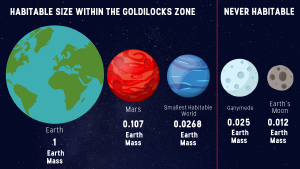Blog
Small Worlds
15 October 2019
 Harvard SEAS
Harvard SEASThere are more than 4,000 known exoplanets in the universe. About four dozen of these are considered “potentially habitable.” While this phrase brings to mind Earth-like worlds, it really just means the planet is the right distance from its star. Not too close to burn up, but not so distant as to freeze. In our solar system that distance range spans roughly from Venus to Mars.
There are many more variables that also go into determining whether a planet is truly habitable. The habitable zones of red dwarfs, for example, are very close to the star, and the atmospheres of close planets may be stripped by strong stellar winds. Gas planets such as Jupiter are so massive they don’t have a solid surface, so even if one was the right distance from a star it wouldn’t be habitable in the way Earth is. At the other extreme, a planet might be too small to hold an atmosphere.
But how small is too small? That’s the question a team answered in a recent article in The Astrophysical Journal.1 The team looked at how the size and mass of a world determines whether it can hold enough atmosphere for liquid water to form on its surface, and stay there for about a billion years.
It turns out that smaller worlds have a few advantages over larger planets like Earth. Earth has a good atmosphere with plenty of surface water. Venus has a similar mass, but its thick atmosphere has given it deadly temperatures and no liquid water. That’s because Venus underwent a runaway greenhouse effect.
Smaller worlds are less likely to have thick atmospheres, so they are less likely to experience runaway greenhouse atmospheres. And the weaker gravity of these worlds means their atmospheres expand more as they get warm. This could give them a thick but not overly dense atmosphere. Perfect for protecting the surface from ultraviolet light and cosmic rays. A thicker atmosphere also helps keep surface temperatures more stable.
But smaller worlds can also lose their atmosphere more easily over time, particularly if they are rather close to their star. If the planet is too small, it won’t hold onto its atmosphere long enough for liquid water to form on its surface.
The team modeled small worlds in the habitable zone of both red dwarfs and G-type stars like our Sun. They found that liquid water could form on a planet’s surface as long as it has at least 2.7% of Earth’s mass. This could partly explain why our Moon doesn’t have a rich atmosphere. It’s the right distance from the Sun, but it is only 1.2% of Earth’s mass.
This research also has implications for so-called warm Jupiters. These are large gas planets in the habitable zone of their star. Such planets would likely have large moons, just as Jupiter does. But the even the largest moons of Jupiter have masses below the critical limit. If Jupiter orbited the Sun where Earth is, the Galilean moons would still not keep liquid water on their surfaces.
Of course other factors would still come into play, but this work does show that the universe of potentially habitable worlds could be much more varied than we once thought.
Arnscheidt, Constantin W., Robin D. Wordsworth, and Feng Ding. “Atmospheric Evolution on Low-Gravity Waterworlds.” The Astrophysical Journal, Volume 881, Number 1 (2019). ↩︎